|
| This category covers wagons designed to carry general merchandise, typically vans and opens. Wagons for bulk loading of loose materials (such as 16ton minerals) have been designated as opens, while some nominally steel-carrying wagons (such as Tube and Pipe wagons) have been included here since they also saw more general use. |
|
Large quantities of traditional 10ft wheelbase vans and opens were replaced by long-wheelbase, air-braked types from the 1970s, alongside which were a number of private owner and ferry vans. The decline in wagonload services and competition from road hauliers has had a large impact on these types, and many were later transferred to departmental use. |
|
| Image |
Type |
Built |
Qty |
Used |
Added |
Edited |
|
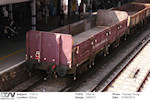 |
OAA/OBA Air-Braked Opens  |
1971-1979 |
900 |
1971-current |
22/12/2007 |
16/03/2010 |
|
The OAA and OBA types were open wagons with steel ends and wooden dropside doors, built in the 1970s for use on Air-Braked Network (ABN, later Speedlink) services. A decline in general merchandise traffic affected the fleet and many of the OBAs were transferred to departmental use within a few years. Later, both types saw a variety of modifications and conversions for other duties.
|
|
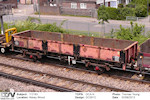 |
OCA General Goods Open Wagons |
1981-1982 |
400 |
1981-current |
1/12/2006 |
17/04/2008 |
|
The OCA was arguably the final development of the traditional, general-purpose open wagon although the decline in general merchandise traffic resulted in the type never being fully employed. Most of the OCAs were soon transferred to departmental use, while others were rebuilt as timber carriers. The latter have now mostly been replaced by bogie types, with the unmodified wagons remaining on infrastructure duties.
|
|
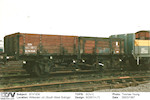 |
SOV/ODA Pipe Wagons  |
1949-1958 |
1950 |
1949-current |
16/12/2007 |
16/12/2007 |
|
Almost 2000 pipe wagons were built by BR, over half of which were vacuum fitted from new. This ensured the survival of many examples until fairly recently. 50 wagons were rebuilt with air brakes in 1983 as ODAs, primarily for MoD use, while many others were transferred to departmental use.
|
|
 |
STV Tube Wagons |
1949-1961 |
3460 |
1949-current |
01/01/2008 |
26/06/2008 |
|
Ask a wagon enthusiast what is longer, a pipe or a tube and they will tell you it is the latter! Both Pipe and Tube were well-established wagon types by the time BR was formed in 1948, and many more were built over the next 14 years. As with the shorter Pipe wagons, the Tubes survived in some numbers into the 1980s, thanks to the vacuum brakes fitted to many. By the 1990s, only departmental wagons remained, although these included some of the earliest built by BR. The last few Tubes were withdrawn in about 2007.
|
|
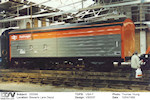 |
VAA/VBA/VCA/VDA Air-Braked Vans |
1969-1977 |
1400 |
1969-current |
22/12/2007 |
Unfinished |
|
These 1400 wagons, built between 1969 and 1978, were BR's first general-purpose air-braked vans, their main use being on the new Air-Braked Network (later Speedlink) services. Although similar in appearance, there were numerous detail differences between and within each batch. The decline in wagonload traffic and the appearance of newer types have seen most of the fleet either condemned or modified for other uses.
|
|
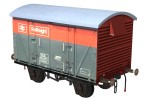 |
VEA/VFA Air-Braked Vanwides  |
1978-1984 |
550 |
1978-c.2000 |
22/12/2007 |
28/05/2008 |
|
The VEA vans (and ODA opens) were traditional wagon designs refurbished and fitted with air brakes in the early 1980s to suit customers who could not handle the longer wheelbase of newer designs. A total of 550 wagons were dealt with and they could be seen across the country on Speedlink trains as well as military specials. A decline in Ministry of Defence requirements lead to most of the wagons being withdrawn in the early 1990s, with just a handful finding further use in the departmental fleets. However, many survived in internal use at Army bases.
|
|
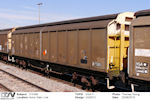 |
VGA/VKA Air-Braked Vans  |
1981-1982 |
251 |
1981-current |
22/12/2007 |
17/05/2008 |
|
Having built 1400 vans to the VAA-VDA pattern in the 1970s, construction turned to the longer VGA design in the 1980s. Based on continental practices of having doors that curve upwards into a central roof panel, a prototype was followed by a single batch of 250 wagons. While their predecessors underwent numerous conversions, the VGAs were retained on revenue duties, carrying a wide variety of commodities. The only development of note was the recoding of many VGAs as VKAs following the fitting of modified journals from 2000 onwards.
|
|
|












